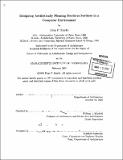Designing aesthetically pleasing freeform surfaces in a computer environment
Author(s)
Smyth, Evan P. (Evan Patrick), 1967-
DownloadFull printable version (27.52Mb)
Other Contributors
Massachusetts Institute of Technology. Dept. of Architecture.
Advisor
William J. Mitchell.
Terms of use
Metadata
Show full item recordAbstract
Statement: If computational tools are to be employed in the aesthetic design of freeform surfaces, these tools must better reflect the ways in which creative designers conceive of and develop such shapes. In this thesis, I studied the design of aesthetically constrained freeform surfaces in architecture and industrial design, formulated a requirements list for a computational system that would aid in the creative design of such surfaces, and implemented a subset of the tools that would comprise such a system. This work documents the clay modeling process at BMW AG., Munich. The study of that process has led to a list of tools that would make freeform surface modeling possible in a computer environment. And finally, three tools from this system specification have been developed into a proof-of-concept system. Two of these tools are sweep modification tools and the third allows a user to modify a surface by sketching a shading pattern desired for the surface. The proof-of-concept tools were necessary in order to test the validity of the tools being presented and they have been used to create a number of example objects. The underlying surface representation is a variational expression which is minimized using the finite element method over an irregular triangulated mesh.
Description
Thesis (Ph. D.)--Massachusetts Institute of Technology, Dept. of Architecture, February 2001. Includes bibliographical references (p. 151-160).
Date issued
2001Department
Massachusetts Institute of Technology. Department of ArchitecturePublisher
Massachusetts Institute of Technology
Keywords
Architecture.